Day 6: Sightseeing in Kyoto
My first weekend is already here and it is exciting given all there is to do here in Kyoto. I slept a little later this morning to catch up on some sleep and then I caught up on the episodes of 24 and Lost that I missed this past week (I downloaded them from iTunes). The Hotta family planned a wonderful day of sightseeing in Kyoto. We started with a breakfast of hard-boiled eggs, lettuce, toast, fruit, a hot dog, yogurt, apple juice, milk, and coffee. It was fortunate for me that the neighbors were having a wedding today, allowing for the opportunity to see the bride and the groom in traditional clothing. The bride was wearing a glowing white kimono with many embroidered white doves. The head dressing of the bride was bright white also, and was quite tall. Once the bride left, the groom came outside to talk to us; the tradition of not seeing the bride before the wedding is the same here. The groom was wearing a black and white kimono almost identical to the one Mr. Hotta is wearing in his wedding pictures.
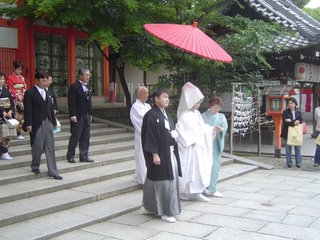 We drove into the city and picked up Kie, the daughter of one of Mr. Hotta's friends. Apparently Kie is going to be studying in the United States for one year, so she wanted to meet me and ask me some questions. I am sure the trip will be shocking for her, especially since she is going to school in South Dakota! We went to an area of Kyoto where there are many streets for walking only. The narrow streets of this area are where much of the tradition of Kyoto lives. There are many shops and it is easy to find women dressed as traditional women or geisha, but the Hotta's told me they were not real, but rather a sort of tourist attraction of their own. We walked to the Yasaka Shrine. The Shrine was beautiful, but wasn't one we could enter. The Yasaka Shrine is a tourist attraction and also a destination for those seeking to pray and worship. One of the items for sale were small wooden plates which, for 500 yen, you could write a prayer or wish and hang it near the Shrine. I chose not to buy one of the plates. We also happened to be at the Shrine for a wedding ceremony. It seems like this time of year is very popular for weddings.
We drove into the city and picked up Kie, the daughter of one of Mr. Hotta's friends. Apparently Kie is going to be studying in the United States for one year, so she wanted to meet me and ask me some questions. I am sure the trip will be shocking for her, especially since she is going to school in South Dakota! We went to an area of Kyoto where there are many streets for walking only. The narrow streets of this area are where much of the tradition of Kyoto lives. There are many shops and it is easy to find women dressed as traditional women or geisha, but the Hotta's told me they were not real, but rather a sort of tourist attraction of their own. We walked to the Yasaka Shrine. The Shrine was beautiful, but wasn't one we could enter. The Yasaka Shrine is a tourist attraction and also a destination for those seeking to pray and worship. One of the items for sale were small wooden plates which, for 500 yen, you could write a prayer or wish and hang it near the Shrine. I chose not to buy one of the plates. We also happened to be at the Shrine for a wedding ceremony. It seems like this time of year is very popular for weddings.

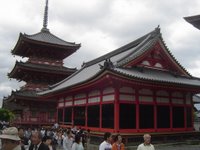
 The next stop was the Kiyomizudera Temple. This temple was near the highest elevation of the old narrow cobblestone streets. There were large steps of stone leading to the tall red gate guarded by two large statues. Looking back I could see the city of Kyoto, the mountains behind it, and another cluster of tall buildings on the horizon. The tall, white and red Kyoto Tower stood out above the buildings. The Kiyomizudera is considered to be a World Cultural Heritage Site and one of the greatest treasures of human kind. Go there and you will see the magnificence it has to offer any visitor. There are several buildings in the mountainside, but the Temple itself is outstanding. Before you enter, you can rinse your hands with the water running from a dragon's mouth into a bath carved from stone. Junpei washed his hands in the water before we went in. We all removed our shoes and entered the temple. Immediately you could smell the incense and sense to powerful silence in the hall. It was dark, but there was enough light to look at the golden statue and the massive pillars holding up the tall ceiling. Junpei kneeled and rang the gong in front of the statue. The gong is more if a large medal bowl, but I gave it a try. I can see why the ringing of the gong is used for prayers: the loud, constant whirring sound it makes fills your ears and clears your mind of all thoughts.
The next stop was the Kiyomizudera Temple. This temple was near the highest elevation of the old narrow cobblestone streets. There were large steps of stone leading to the tall red gate guarded by two large statues. Looking back I could see the city of Kyoto, the mountains behind it, and another cluster of tall buildings on the horizon. The tall, white and red Kyoto Tower stood out above the buildings. The Kiyomizudera is considered to be a World Cultural Heritage Site and one of the greatest treasures of human kind. Go there and you will see the magnificence it has to offer any visitor. There are several buildings in the mountainside, but the Temple itself is outstanding. Before you enter, you can rinse your hands with the water running from a dragon's mouth into a bath carved from stone. Junpei washed his hands in the water before we went in. We all removed our shoes and entered the temple. Immediately you could smell the incense and sense to powerful silence in the hall. It was dark, but there was enough light to look at the golden statue and the massive pillars holding up the tall ceiling. Junpei kneeled and rang the gong in front of the statue. The gong is more if a large medal bowl, but I gave it a try. I can see why the ringing of the gong is used for prayers: the loud, constant whirring sound it makes fills your ears and clears your mind of all thoughts.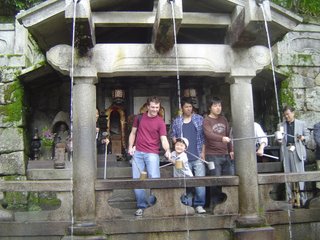 I used to use a similar method when my thoughts would keep me awake at night; by humming I could focus on the noise only and clear my mind of all other thoughts. Then, I could fall asleep peacefully. Sounds silly, but it actually works pretty well. Out the side of the Temple there is a large platform, which was used for ceremonial dances, hanging over the mountainside. When we walked down into the valley,we could see that the deck was supported by a scaffolding made of large timbers and held together with out nails. It is impressive. Junpei's mother, Junpei, and I drank from the Otowanotaki Spring. This spring is supposedly one of the three most pure sources of water in Japan. The name of the Temple, Kiyomizu, literally means, "pure water." I hope to go back to the Kiyomizudera Temple, even during this trip.
I used to use a similar method when my thoughts would keep me awake at night; by humming I could focus on the noise only and clear my mind of all other thoughts. Then, I could fall asleep peacefully. Sounds silly, but it actually works pretty well. Out the side of the Temple there is a large platform, which was used for ceremonial dances, hanging over the mountainside. When we walked down into the valley,we could see that the deck was supported by a scaffolding made of large timbers and held together with out nails. It is impressive. Junpei's mother, Junpei, and I drank from the Otowanotaki Spring. This spring is supposedly one of the three most pure sources of water in Japan. The name of the Temple, Kiyomizu, literally means, "pure water." I hope to go back to the Kiyomizudera Temple, even during this trip.
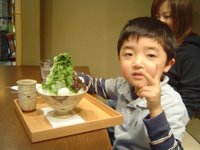
 The Hotta family, Kie, and I worked our way down through the streets and stopped at a noodle shop for some lunch. I had Japanese noodles and tempura (fried shrimp), which was delicious. I didn't like the soy tea very much, but it was not horrible either. Junpei really wanted some dessert, so we made another stop just down the street. Junpei ordered a huge serving of green tea-flavored shaved ice. He was so eager to eat it that he ended up with brain freeze several times. They all thought it was funny that we call it "brain freeze." The rest of us had some green tea flavored ice cream sundaes, which were tasty. While we continued down the street I tried to soak in all my surroundings: the small shops with Japanese pottery, Junpei stopping to look at every toy, the spectacular view of the city, and the smells of incense, good food, and wood fires filling the mountain air.
The Hotta family, Kie, and I worked our way down through the streets and stopped at a noodle shop for some lunch. I had Japanese noodles and tempura (fried shrimp), which was delicious. I didn't like the soy tea very much, but it was not horrible either. Junpei really wanted some dessert, so we made another stop just down the street. Junpei ordered a huge serving of green tea-flavored shaved ice. He was so eager to eat it that he ended up with brain freeze several times. They all thought it was funny that we call it "brain freeze." The rest of us had some green tea flavored ice cream sundaes, which were tasty. While we continued down the street I tried to soak in all my surroundings: the small shops with Japanese pottery, Junpei stopping to look at every toy, the spectacular view of the city, and the smells of incense, good food, and wood fires filling the mountain air.
The last stop of the day was the Sanjusan Gendo. Unfortunately, the temple doesn't allow people to take pictures inside, but some are available online or in books. The Sanjusan Gendo is a building fourteen meters wide and one-hundred and twenty meters long! "Sanjusan" means 33 in Japanese, referring to the number of large pillars from one end of the building to the other. Inside the building, 1,001 golden Buddha statues stand at the ready. Each of the figures has 42 arms, and is slightly different than the others. They might have a completely different face, or them might appear different only in the folds of their clothing. It looks as if an army of gold men are standing in a stadium-like seating arrangement. All I could do was stare...over 1,000 of them...simply breathtaking. In the center of the building there stands one enormous Buddha. In front of those statues stand a row of 28 crystal-eyed deities. The two on the ends are the most famous, Fujin (god of wind) and Raigin (god of thunder). Fujin and Raigin are often placed at entrances in order to stop evilness and allow virtue to pass. In the center of the building stands one large golden Buddha. People leave gifts there, pray, and burn incense sticks for Buddha. Whatever powers one might believe in, standing before the large Buddha amongst all of those statues will make anyone sense the power there.
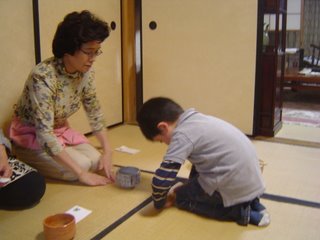 We went home for dinner and had temakizushi, which is simply self serve sushi. We rolled our own combinations of tuna, cucumber, avocado, rice, and dipped them in soy sauce and wasabi. After some emails, Mrs. Hotta had a surprise prepared for me. She teaches flower arrangement and tea ceremony, and so she prepared a private tea ceremony for her family and I. I was relieved to have my first tea ceremony be very informal. Mrs. Hotta helped me understand how the ceremony is done and what I need to do. Junpei was our server and, as always, he made us laugh.
We went home for dinner and had temakizushi, which is simply self serve sushi. We rolled our own combinations of tuna, cucumber, avocado, rice, and dipped them in soy sauce and wasabi. After some emails, Mrs. Hotta had a surprise prepared for me. She teaches flower arrangement and tea ceremony, and so she prepared a private tea ceremony for her family and I. I was relieved to have my first tea ceremony be very informal. Mrs. Hotta helped me understand how the ceremony is done and what I need to do. Junpei was our server and, as always, he made us laugh.
 We drove into the city and picked up Kie, the daughter of one of Mr. Hotta's friends. Apparently Kie is going to be studying in the United States for one year, so she wanted to meet me and ask me some questions. I am sure the trip will be shocking for her, especially since she is going to school in South Dakota! We went to an area of Kyoto where there are many streets for walking only. The narrow streets of this area are where much of the tradition of Kyoto lives. There are many shops and it is easy to find women dressed as traditional women or geisha, but the Hotta's told me they were not real, but rather a sort of tourist attraction of their own. We walked to the Yasaka Shrine. The Shrine was beautiful, but wasn't one we could enter. The Yasaka Shrine is a tourist attraction and also a destination for those seeking to pray and worship. One of the items for sale were small wooden plates which, for 500 yen, you could write a prayer or wish and hang it near the Shrine. I chose not to buy one of the plates. We also happened to be at the Shrine for a wedding ceremony. It seems like this time of year is very popular for weddings.
We drove into the city and picked up Kie, the daughter of one of Mr. Hotta's friends. Apparently Kie is going to be studying in the United States for one year, so she wanted to meet me and ask me some questions. I am sure the trip will be shocking for her, especially since she is going to school in South Dakota! We went to an area of Kyoto where there are many streets for walking only. The narrow streets of this area are where much of the tradition of Kyoto lives. There are many shops and it is easy to find women dressed as traditional women or geisha, but the Hotta's told me they were not real, but rather a sort of tourist attraction of their own. We walked to the Yasaka Shrine. The Shrine was beautiful, but wasn't one we could enter. The Yasaka Shrine is a tourist attraction and also a destination for those seeking to pray and worship. One of the items for sale were small wooden plates which, for 500 yen, you could write a prayer or wish and hang it near the Shrine. I chose not to buy one of the plates. We also happened to be at the Shrine for a wedding ceremony. It seems like this time of year is very popular for weddings.

 The next stop was the Kiyomizudera Temple. This temple was near the highest elevation of the old narrow cobblestone streets. There were large steps of stone leading to the tall red gate guarded by two large statues. Looking back I could see the city of Kyoto, the mountains behind it, and another cluster of tall buildings on the horizon. The tall, white and red Kyoto Tower stood out above the buildings. The Kiyomizudera is considered to be a World Cultural Heritage Site and one of the greatest treasures of human kind. Go there and you will see the magnificence it has to offer any visitor. There are several buildings in the mountainside, but the Temple itself is outstanding. Before you enter, you can rinse your hands with the water running from a dragon's mouth into a bath carved from stone. Junpei washed his hands in the water before we went in. We all removed our shoes and entered the temple. Immediately you could smell the incense and sense to powerful silence in the hall. It was dark, but there was enough light to look at the golden statue and the massive pillars holding up the tall ceiling. Junpei kneeled and rang the gong in front of the statue. The gong is more if a large medal bowl, but I gave it a try. I can see why the ringing of the gong is used for prayers: the loud, constant whirring sound it makes fills your ears and clears your mind of all thoughts.
The next stop was the Kiyomizudera Temple. This temple was near the highest elevation of the old narrow cobblestone streets. There were large steps of stone leading to the tall red gate guarded by two large statues. Looking back I could see the city of Kyoto, the mountains behind it, and another cluster of tall buildings on the horizon. The tall, white and red Kyoto Tower stood out above the buildings. The Kiyomizudera is considered to be a World Cultural Heritage Site and one of the greatest treasures of human kind. Go there and you will see the magnificence it has to offer any visitor. There are several buildings in the mountainside, but the Temple itself is outstanding. Before you enter, you can rinse your hands with the water running from a dragon's mouth into a bath carved from stone. Junpei washed his hands in the water before we went in. We all removed our shoes and entered the temple. Immediately you could smell the incense and sense to powerful silence in the hall. It was dark, but there was enough light to look at the golden statue and the massive pillars holding up the tall ceiling. Junpei kneeled and rang the gong in front of the statue. The gong is more if a large medal bowl, but I gave it a try. I can see why the ringing of the gong is used for prayers: the loud, constant whirring sound it makes fills your ears and clears your mind of all thoughts. I used to use a similar method when my thoughts would keep me awake at night; by humming I could focus on the noise only and clear my mind of all other thoughts. Then, I could fall asleep peacefully. Sounds silly, but it actually works pretty well. Out the side of the Temple there is a large platform, which was used for ceremonial dances, hanging over the mountainside. When we walked down into the valley,we could see that the deck was supported by a scaffolding made of large timbers and held together with out nails. It is impressive. Junpei's mother, Junpei, and I drank from the Otowanotaki Spring. This spring is supposedly one of the three most pure sources of water in Japan. The name of the Temple, Kiyomizu, literally means, "pure water." I hope to go back to the Kiyomizudera Temple, even during this trip.
I used to use a similar method when my thoughts would keep me awake at night; by humming I could focus on the noise only and clear my mind of all other thoughts. Then, I could fall asleep peacefully. Sounds silly, but it actually works pretty well. Out the side of the Temple there is a large platform, which was used for ceremonial dances, hanging over the mountainside. When we walked down into the valley,we could see that the deck was supported by a scaffolding made of large timbers and held together with out nails. It is impressive. Junpei's mother, Junpei, and I drank from the Otowanotaki Spring. This spring is supposedly one of the three most pure sources of water in Japan. The name of the Temple, Kiyomizu, literally means, "pure water." I hope to go back to the Kiyomizudera Temple, even during this trip.
 The Hotta family, Kie, and I worked our way down through the streets and stopped at a noodle shop for some lunch. I had Japanese noodles and tempura (fried shrimp), which was delicious. I didn't like the soy tea very much, but it was not horrible either. Junpei really wanted some dessert, so we made another stop just down the street. Junpei ordered a huge serving of green tea-flavored shaved ice. He was so eager to eat it that he ended up with brain freeze several times. They all thought it was funny that we call it "brain freeze." The rest of us had some green tea flavored ice cream sundaes, which were tasty. While we continued down the street I tried to soak in all my surroundings: the small shops with Japanese pottery, Junpei stopping to look at every toy, the spectacular view of the city, and the smells of incense, good food, and wood fires filling the mountain air.
The Hotta family, Kie, and I worked our way down through the streets and stopped at a noodle shop for some lunch. I had Japanese noodles and tempura (fried shrimp), which was delicious. I didn't like the soy tea very much, but it was not horrible either. Junpei really wanted some dessert, so we made another stop just down the street. Junpei ordered a huge serving of green tea-flavored shaved ice. He was so eager to eat it that he ended up with brain freeze several times. They all thought it was funny that we call it "brain freeze." The rest of us had some green tea flavored ice cream sundaes, which were tasty. While we continued down the street I tried to soak in all my surroundings: the small shops with Japanese pottery, Junpei stopping to look at every toy, the spectacular view of the city, and the smells of incense, good food, and wood fires filling the mountain air.The last stop of the day was the Sanjusan Gendo. Unfortunately, the temple doesn't allow people to take pictures inside, but some are available online or in books. The Sanjusan Gendo is a building fourteen meters wide and one-hundred and twenty meters long! "Sanjusan" means 33 in Japanese, referring to the number of large pillars from one end of the building to the other. Inside the building, 1,001 golden Buddha statues stand at the ready. Each of the figures has 42 arms, and is slightly different than the others. They might have a completely different face, or them might appear different only in the folds of their clothing. It looks as if an army of gold men are standing in a stadium-like seating arrangement. All I could do was stare...over 1,000 of them...simply breathtaking. In the center of the building there stands one enormous Buddha. In front of those statues stand a row of 28 crystal-eyed deities. The two on the ends are the most famous, Fujin (god of wind) and Raigin (god of thunder). Fujin and Raigin are often placed at entrances in order to stop evilness and allow virtue to pass. In the center of the building stands one large golden Buddha. People leave gifts there, pray, and burn incense sticks for Buddha. Whatever powers one might believe in, standing before the large Buddha amongst all of those statues will make anyone sense the power there.
 We went home for dinner and had temakizushi, which is simply self serve sushi. We rolled our own combinations of tuna, cucumber, avocado, rice, and dipped them in soy sauce and wasabi. After some emails, Mrs. Hotta had a surprise prepared for me. She teaches flower arrangement and tea ceremony, and so she prepared a private tea ceremony for her family and I. I was relieved to have my first tea ceremony be very informal. Mrs. Hotta helped me understand how the ceremony is done and what I need to do. Junpei was our server and, as always, he made us laugh.
We went home for dinner and had temakizushi, which is simply self serve sushi. We rolled our own combinations of tuna, cucumber, avocado, rice, and dipped them in soy sauce and wasabi. After some emails, Mrs. Hotta had a surprise prepared for me. She teaches flower arrangement and tea ceremony, and so she prepared a private tea ceremony for her family and I. I was relieved to have my first tea ceremony be very informal. Mrs. Hotta helped me understand how the ceremony is done and what I need to do. Junpei was our server and, as always, he made us laugh.


0 Comments:
Post a Comment
<< Home